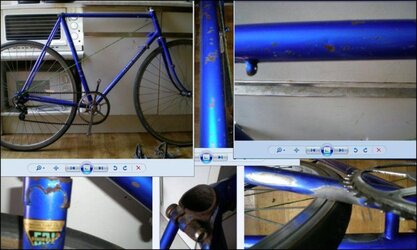Ed no-more-lemons
Veteran
- Location
- The Burbs
Hi
I have recently got my hands on a pair of Claud Butler(Holdsworth) Electron Fives(One a ten speed and the other a cottered crank), certainly the oldest bikes I have ever owned.
OK I got carried away with the second, but was always partly with a view to parts. Anyway this second machine was cheeper due to poor photos etc.
Turns out the drop-outs have been widened, cold set(I am unfamiliar with this process) or botched more likely to accept a newer quick release housing, shudder.
The quick release housing spacers whatever measure 135mm
The drop-out without the wheel wedged in measure 127mm
The unmolested bikes drop-outs are 120mm
Presumably this has been achieved by brute force, however the stays appear more or less symmetrical. On close inspection of the chain stays the paint appeared to show 15-20mm lines on both undersides along the length of the stay.
Queue the 'wet and dry' back too metal at these points, all seems ok no cracks some fatigue surely!
I am looking for any feedback especially regarding the safety implications, what cold setting involves and whether further manipulation would be feasible/advisable.
I have taken numerous picky's but do not have a Flickr account, which I can create should the need arise.
TTFN, BTW proper poor spelling and grammar probably, but hoping the query is clear
I have recently got my hands on a pair of Claud Butler(Holdsworth) Electron Fives(One a ten speed and the other a cottered crank), certainly the oldest bikes I have ever owned.
OK I got carried away with the second, but was always partly with a view to parts. Anyway this second machine was cheeper due to poor photos etc.
Turns out the drop-outs have been widened, cold set(I am unfamiliar with this process) or botched more likely to accept a newer quick release housing, shudder.
The quick release housing spacers whatever measure 135mm
The drop-out without the wheel wedged in measure 127mm
The unmolested bikes drop-outs are 120mm
Presumably this has been achieved by brute force, however the stays appear more or less symmetrical. On close inspection of the chain stays the paint appeared to show 15-20mm lines on both undersides along the length of the stay.
Queue the 'wet and dry' back too metal at these points, all seems ok no cracks some fatigue surely!
I am looking for any feedback especially regarding the safety implications, what cold setting involves and whether further manipulation would be feasible/advisable.
I have taken numerous picky's but do not have a Flickr account, which I can create should the need arise.
TTFN, BTW proper poor spelling and grammar probably, but hoping the query is clear


